Виж този текст на български език ![]()
For the time being there are no indisputable data from the Lower Danube region for succession among the settlements of the local population from the pre-Roman period and the new agrarian settlements, including the villas, from the time of the Principate. There are known cases of adjacency or even overlap of a pre-Roman settlement and a Roman villa, but the attempt to see in them something more of a topographic continuum would be an overinterpretation. For the time being no examples have been established of the so-called local farms, which are related to the pre-Roman traditions in the organization of the rural economy and which have been established in some other European territories of the Empire for the time of the Principate.
Due to the still scarce information about the settlements of the local population along the Lower Danube from the last centuries before Christ, it is difficult to estimate today to what extent the known and archaeologically studied here villages from the time of the Principate have preserved the earlier local traditions in their development and architecture.
The villas and the villas rusticae, in particular are a new phenomenon for the Lower Danube region, which is related to the establishment and development of province Moesia (Superior and Inferior after 86). They are a representation of the Roman organizational models and production relations in the rural economy.
The villa (villa rustica) is an economic unit with an autonomous organization and immediate realization of the production process. The participation of its owner in the organization of the production can be direct or indirect – through a manager (vilicus). The villa is always within the respective land property (fundus), which can be significant or more limited, but not small. As a result, it is an independent settlement unit and, respectively – the villas are a separate form of settlement life.
Many publications on the Roman villas, including those from Moesia refer to, apart from actually studied villas, sites known only from field trips or limited drills. Quite often villas are "established" only through epigraphic monuments of a general nature (for example, tombstones) even the origin of which is sometimes not clear. I will not go into the identification problems here, but I would like to emphasize that the next presentation of the villas in Moesiа is based on sites whose proper archaeological study has been completed or is at an advanced stage.
Ventzislav Dintchev
Baumann, V. Ferma romana din Dobrogea. Tulcea, 1983.
Baumann, V. Fermiers et autochtones dans la Dobroudja romaine. - Іn: V. Baumann (ed.). La politique йdilitaire dans les provinces de l’ Empire romain IIe - IVe siècles après J.-C., Actes du IIIe Colloque Roumano-Suisse "La vie rurale dans les provinces romaines: vici et villas", Tulcea, 1998, 243-259.
Bender, H. Die lä ndliche Besiedlung und Landwirtschaft in Obermoesien wä hrend der Kaiserzeit (bis zum 5. Jahrhundert einschliesslich).- In: H. Bender, H. Wolff (eds.), Lä ndlische Besiedlung und Landwirtsshaft in der Rhein-Donau-Provinzen des Rö mischen Reiches (Passauer Universitä tsschriften zur Archä ologie, 2), Passau, 1994, 451-461, Abb. 20/1-8.
Dinchev, V. - Динчев, В. Римските вили в днешната българска територия (Roman Villas in the Present-Day Bulgarian Lands). София, 1997.
Gerov, B. - Геров, Б. Земевладението в римска Тракия и Moesia, I-III в. (Der Besitz an Grund und Boden im rö mischen Thrakien und Mö sien, 1.-3. Jh.) (= Годишник на Софийския университет, Факултет по класически и нови филологии, LXXII, 2) София, 1980.
Henning, J. Die lä ndliche Besiedlung im Umland von Sadovec, Nordbulgarien (Vit-Tal) und die rö mischen Agrarstrukturen im europä ischen Vorland von Byzanz (Thrakien/Niedermö sien). - in: H. Bender, H. Wolff (eds), Lä ndlische Besiedlung und Landwirtsshaft..., 463-503, Abb. 21/1-27.
Mocsy, A. Gesellschaft und Romanisation in der rö mischen Provinz Moesia Superior. Budapest, 1970.
Poulter, A. Town and Country in Moesia Inferior. - in: A. Poulter (ed.). Ancient Bulgaria. P. 2. Nottingham, 1983, 74-119.
The villa can vary from a single building to an expanded complex of different buildings and facilities. What is common in the characteristics of all villas is that they represent a unified structure of residential and economic units, among which the central unit and unifying kernel is the residence of the owner.
Depending on the rank of the homes of the owners, two main groups can be distinguished among the Roman villas: villas lacking a representative residential part (group I); villas with a representative residential part (group II). Within the latter it is worthwhile to distinguish the so-called residencies – the most significant villas complexes with the largest and most representative residential buildings (group III).
In view of the definition and classification adopted here, the villas suburbanae cannot be differentiated in a separate group. If villa suburbana is interpreted as a dwelling in the suburbs of a city, then its analysis should form a part of the characterization of the development and architecture of the respective city.
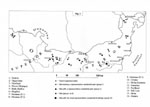
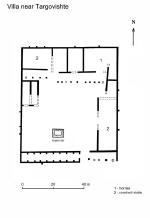 Among the studied villas from the time of the Principate on the territory of Moesia without a representative residential part are those at Vardim (near Svishtov,
dep. of Veliko Turnovo, BG), near Targovishte and at Niculiţel (dep. of Tulcea, RO). Due to partial studies or lack of sufficient published
information, some villas cannot be precisely classified for the time being
(as group I or group II)
– those in the area Maitapa near Pleven (BG) and near Bjala Cherkva (dep. of
Veliko Turnovo, BG). The complex studied near Mogiletz (dep. of Targovishte,
BG) is also of uncertain identification (villa from group
I, economic part of a villa from group II or a rural household).
Among the studied villas from the time of the Principate on the territory of Moesia without a representative residential part are those at Vardim (near Svishtov,
dep. of Veliko Turnovo, BG), near Targovishte and at Niculiţel (dep. of Tulcea, RO). Due to partial studies or lack of sufficient published
information, some villas cannot be precisely classified for the time being
(as group I or group II)
– those in the area Maitapa near Pleven (BG) and near Bjala Cherkva (dep. of
Veliko Turnovo, BG). The complex studied near Mogiletz (dep. of Targovishte,
BG) is also of uncertain identification (villa from group
I, economic part of a villa from group II or a rural household).
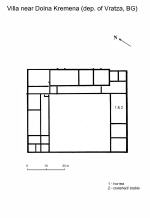 The villa near Dolna Kremena (dep. of Vratza, BG) is near the classification border between group I and group
II and it is classified as group II with certain reservations.
The villa near Dolna Kremena (dep. of Vratza, BG) is near the classification border between group I and group
II and it is classified as group II with certain reservations.
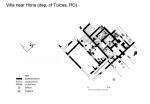 The information available on some partially studied villas from 2nd – 3rd c. proves or presupposes the presence of representative residential parts –
for example, the villas at Smochan (dep. of Lovech, BG), at Beli Lom (dep.
of Razgrad, BG) and at Horia (dep. of Tulcea, RO). The villas at Urvene (dep. of Vratza, BG) and near Pavlikeni
(dep. of Veliko Turnovo, BG) have a representative residential part. The three
studied villas near Montana (dep. of Montana, BG), (villa 1, villa 2 villa 3),
which have similar structures and development, belong indisputably to group
II.
The information available on some partially studied villas from 2nd – 3rd c. proves or presupposes the presence of representative residential parts –
for example, the villas at Smochan (dep. of Lovech, BG), at Beli Lom (dep.
of Razgrad, BG) and at Horia (dep. of Tulcea, RO). The villas at Urvene (dep. of Vratza, BG) and near Pavlikeni
(dep. of Veliko Turnovo, BG) have a representative residential part. The three
studied villas near Montana (dep. of Montana, BG), (villa 1, villa 2 villa 3),
which have similar structures and development, belong indisputably to group
II.
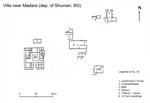
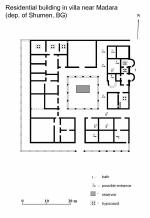 From the villas known from Moesia from the time of the Principate, the one at Madara (dep. of Shumen, BG) Pln09EN-html is the most significant and with the most representative residential part. It
is an example of a villa from group III.
From the villas known from Moesia from the time of the Principate, the one at Madara (dep. of Shumen, BG) Pln09EN-html is the most significant and with the most representative residential part. It
is an example of a villa from group III.
The architectural and typological characterization of the residential buildings of the Moesian villas shows variety and adoption of different models. The central dwellings of the villas at Madara and Beli Lom are peristyle buildings, as is most probably the villa near Pavlikeni. The central building of villa N 2 near Montana has a representative inner yard but without porticos. The central residential buildings of the other two villas near Montana (dep. of Montana, BG), (villa 1, villa 2 villa 3) and the villa at Urvene have premises grouped in a block. They can be classified as hall houses. The partially uncovered residential building of the villa at Horia also seems to belong to this group.
Premises grouped in a block also characterize the residential buildings of the villas at Targovishte, Niculiţel and Dolna Kremena. These, however, are not differentiated but included in general architectural complexes with the economic units of the villas.
The central residential wing of the villa at Dolna Kremena has a representative portico. The residency at Madara also has external porticos. Their façade porticos bring these villas close to the most widespread type of villa building in the west and middle European provinces of the Empire (corridor/porticus-villa; villa à galerie de facade; Portikusvilla). The combination of external portico and peristyle, such as the one in the residency at Madara, is also a known phenomenon – in most of the larger villas in Pannonia, for example.
Ventzislav Dintchev
Alexandrov, G. – Александров, Г. Антична вила N 2 край Монтана (An antique villa N 2 near the town of Montana). - Известия на музеите от Северозападна България, 4, 1980, 9-64.
Alexandrov, G. – Александров, Г. Антична вила N 1 край Михайловград (An ancient villa N 1 near Mikhailovgrad). - Известия на музеите от Северозападна България, 8, 1983, 37-81.
Alexandrov, G. – Александров, Г. Антична вила N 3 край Михайловград (An antic villa N 3 near Mikhailovgrad). - Известия на музеите от Северозападна България, 9, 1984, 9-45.
Baumann, V. Ferma romana din Dobrogea. Tulcea, 1983.
Dinchev, V. - Динчев, В. Римските вили в днешната българска територия (Roman Villas in the Present-Day Bulgarian Lands). София, 1997.
Dremsizova-Nelc inova, Cv. La villa romaine en Bulgarie. - in: Actes du Ier Congres international des etudes balkaniques et sud-est europeenne. T. II. Sofia, 1970, 503-512.
Dremsizova-Nelc inova, Cv. - Дремсизова-Нелчинова, Цв. Вилата край с. Мадара, Шуменски окръг (La villa situйe près du village de Madara, dep. de Šumen). – Разкопки и проучвания, ХІ, 1984, 74-126.
Ginev, G. - Гинев, Г. Вила рустика при Търговище (Villa rustica près de Tărgovište). - Археология, ХХVII, 1986, 1, 29-36.
Henning, J. Die lä ndliche Besiedlung im Umland von Sadovec, Nordbulgarien (Vit-Tal) und die rö mischen Agrarstrukturen im europä ischen Vorland von Byzanz (Thrakien/Niedermö sien). - in: H. Bender, H. Wolff (eds), Lä ndlische Besiedlung und Landwirtsshaft..., 463-503, Abb. 21/1-27.
Mashov, S. - Машов, С. Римска вила рустика при с. Долна Кремена, Михайловградска област (Roman villa rustica near Dolna Kremena, dep. of Mikhailovgrad). - Известия на музеите от Северозападна България, 14, 1988, 19-42.
Оvčarov, D. - Овчаров, Д. Вила рустика до с. Могилец, Търговищко (Villa rustica près du village Mogiletz, région de Tărgovište). - Археология, ХI, 1969, 1, 26-35.
Poulter, A. Town and Country in Moesia Inferior. - in: A. Poulter (ed.). Ancient Bulgaria. P. 2. Nottingham, 1983, 74-119.
Sultov, B. Сeramic Production on the Territory of Nicopolis ad Istrum (Ind - IVth century ). Terra Antiqua Balkanica. T. I (= ГСУ ИФ, XXVI, 2 ). Sofia, 1985.
The presence of heated residential premises, bathhouses, mosaics, frescos and/or stone plastic decoration is a sign for representativeness, i.e. for the respective villa belonging to group II or III.
Heated with a hypocaust are usually part of the premises for personal use (cubicula) and the official reception premises (triclinia) in the residential buildings of the villa owners. From the studied villas with representative residential parts from the time of the Principate in Moesia, heated residential premises have been established at those near Montana (villa 1, villa 2 villa 3), at Urvene, at Pavlikeni, at Madara, at Horia.
Due to their private nature, the villa bathhouses are relatively modest in size and include not more than 4-5 rooms. They are separate buildings or are included in the main residential buildings of the respective villas. Bathhouses have been uncovered at the villas near Montana, (villa 1, villa 2 villa 3), at Urvene, at Smochan, at Pavlikeni, at Маdara, at Horia. In villa N 2 near Montana and in the villa residency near Madara there are also separate bathhouses for the servants.
No villa floor mosaic from the time of the Principate has been uncovered so far on the territory of Moesia. Coloured frescos covered the walls of part of the rooms of the villa residency at Madara. Now we have more examples of stone plastic decoration among the local villas from 2nd – 3rd c. Thus, together with the Ionic colonnade, stone hermae were used in the decoration of the corridor in front of the residential wing of the villa near Dolna Kremena. Ionic colonnades were also present in the peristyle yards of the villas at Pavlikeni and Beli Lom. Plastic stone decoration (capitels, railings, etc.) was also used in the main residential buildings of the villas near Montana. Impressive Dorian colonnade and a beautiful pool (impluvium) formed the peristyle of the villa residency at Madara.
Ventzislav Dintchev
Alexandrov, G. – Александров, Г. Антична вила N 2 край Монтана (An antique villa N 2 near the town of Montana). - Известия на музеите от Северозападна България, 4, 1980, 9-64.
Alexandrov, G. – Александров, Г. Антична вила N 1 край Михайловград (An ancient villa N 1 near Mikhailovgrad). - Известия на музеите от Северозападна България, 8, 1983, 37-81.
Alexandrov, G. – Александров, Г. Антична вила N 3 край Михайловград (An antic villa N 3 near Mikhailovgrad). - Известия на музеите от Северозападна България, 9, 1984, 9-45.
Baumann, V. Ferma romana din Dobrogea. Tulcea, 1983.
Dinchev, V. - Динчев, В. Римските вили в днешната българска територия (Roman Villas in the Present-Day Bulgarian Lands). София, 1997.
Dremsizova-Nelc inova, Cv. - Дремсизова-Нелчинова, Цв. Вилата край с. Мадара, Шуменски окръг (La villa situйe près du village de Madara, dep. de Šumen). – Разкопки и проучвания, ХІ, 1984, 74-126.
Henning, J. Die lä ndliche Besiedlung im Umland von Sadovec, Nordbulgarien (Vit-Tal) und die rö mischen Agrarstrukturen im europä ischen Vorland von Byzanz (Thrakien/Niedermö sien). - in: H. Bender, H. Wolff (eds), Lä ndlische Besiedlung und Landwirtsshaft..., 463-503, Abb. 21/1-27.
Mashov, S. - Машов, С. Римска вила рустика при с. Долна Кремена, Михайловградска област (Roman villa rustica near the v. Dolna Kremena, dep. of Mihajlovgrad) - Известия на музеите от Северозападна България, 14, 1988, 19-42.
Poulter, A. Town and Country in Moesia Inferior. - in: A. Poulter (ed.). Ancient Bulgaria. P. 2. Nottingham, 1983, 74-119.
Sultov, B. Сeramic Production on the Territory of Nicopolis ad Istrum (Ind - IVth century ). Terra Antiqua Balkanica. T. I (= ГСУ ИФ, XXVI, 2 ). Sofia, 1985.
The topographic data about the known villas from the type of the Principate in Moesia show that defining for the choice of location were the very natural conditions, which predetermine the location of the synchronous villages – a terrain suitable for inhabiting, proximity to a water source, fertile environment. The villas known are not in the immediate vicinity of the main roads in the province but their location provides the possibility of relatively easy outlet both to the main roads and the nearby settlement and/or military centres.
The earliest from the known villas in Moesia is that near Madara. It was probably constructed in the second half of 1st c. and at the beginning of 2nd c. it already had a shaped structure. The villa near Pavlikeni is also dated to the very beginning of 2nd c. The data on the appearance of the other villas evidence a gradual process of the increase in their number. The end date - before the middle of 3rd c. – about 170 – is assumed only for the villa near Pavlikeni. This dating, however, is not indisputable, i.e. it is not impossible that the villa functioned after 170. The villas near Montana are assumed to have appeared in the second half of 2nd c. – beginning of 3rd c. From the findings made public, however, only the epigraphic monuments used as spolia are positively dateable towards the middle of 3rd c. This is the reason why a later date of first appearance for these villas is not ruled out, within 3rd c. Such a possibility is also admissible for the villa at Urvene, a publication on which is still not available.
Ventzislav Dintchev
Alexandrov, G. –Александров, Г. Антична вила N 2 край Монтана (An antique villa N 2 near the town of Montana). - Известия на музеите от Северозападна България, 4, 1980, 9-64.
Alexandrov, G. –Александров, Г. Антична вила N 1 край Михайловград (An ancient villa N 1 near Mikhailovgrad). - Известия на музеите от Северозападна България, 8, 1983, 37-81.
Alexandrov, G. –Александров, Г. Антична вила N 3 край Михайловград (An antic villa N 3 near Mikhailovgrad). - Известия на музеите от Северозападна България, 9, 1984, 9-45.
Baumann, V. Ferma romana din Dobrogea. Tulcea, 1983.
Dinchev, V. - Динчев, В. Римските вили в днешната българска територия (Roman Villas in the Present-Day Bulgarian Lands). София, 1997.
Dremsizova-Nelc inova, Cv. - Дремсизова-Нелчинова, Цв. Вилата край с. Мадара, Шуменски окръг (La villa situйe près du village de Madara, dep. de Šumen). – Разкопки и проучвания, ХІ, 1984, 74-126.
Ginev, G. - Гинев, Г. Вила рустика при Търговище (Villa rustica près de Tărgovište). - Археология, ХХVII, 1986, 1, 29-36.
Henning, J. Die lä ndliche Besiedlung im Umland von Sadovec, Nordbulgarien (Vit-Tal) und die rö mischen Agrarstrukturen im europä ischen Vorland von Byzanz (Thrakien/Niedermö sien). - in: H. Bender, H. Wolff (eds), Lä ndlische Besiedlung und Landwirtsshaft..., 463-503, Abb. 21/1-27.
Mashov, S. - Машов, С. Римска вила рустика при с. Долна Кремена, Михайловградска област (Roman villa rustica near Dolna Kremena, dep. of Mikhailovgrad). - Известия на музеите от Северозападна България, 14, 1988, 19-42.
Оvčarov, D. - Овчаров, Д. Вила рустика до с. Могилец, Търговищко (Villa rustica près du village Mogiletz, région de Tărgovište). - Археология, ХI, 1969, 1, 26-35.
Poulter, A. Town and Country in Moesia Inferior. - in: A. Poulter (ed.). Ancient Bulgaria. P. 2. Nottingham, 1983, 74-119.
Sultov, B. Сeramic Production on the Territory of Nicopolis ad Istrum (Ind - IVth century ). Terra Antiqua Balkanica. T. I (= ГСУ ИФ, XXVI, 2 ). Sofia, 1985.
A leading branch in the economy of the villas during the Principate in Moesia was agriculture and mainly the production of grain. It is not by chance that in all entirely studied villas, including those from group I, there are large warehouses for grainl. The presence of the latter and the numerous agricultural inventory found during the excavations at the villas clearly show that the basis for the well-being of their owners was indeed grain production. The current information about the other agricultural activities developed at the villas is relatively scarce for the time being. Some of the workers in 2nd – 3rd c. in the villa residency at Madara, for example, worked in vine growing and wine production.
Cattle breeding also had large significance for the villas. The cattle sheds, like the grain warehouses, are also invariably present links in the structure of the entirely studied villas. Cattle breeding and horse breeding and large cattle, in particular, was necessary for the development of agriculture. As with the latter, most probably part of the production from cattle breeding – live animals, leather, wool, etc. – was meant for the market.
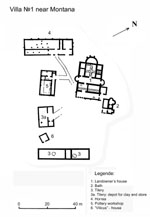
 Different crafts were also developed at the villas in Moesia. Findings such as wharves for spindles and weights for looms prove the practice
of spinning and weaving for own needs. The iron and stone workshops discovered
in some more significant complexes – for example those near Montana served a similar purpose. Buildings and facilities related to the production
of construction and/or household ceramics – workshops, driers, separately situated
furnaces, pits for clay ageing, etc. – have been found in the villas near Montana, (villa 1, villa 2), in those near Pavlikeni, near
Bjala cherkva, in the villa residency at Маdara. The production of household ceramics is also assumed for the villa
at Beli Lom. The production of the furnaces for construction ceramics in the
more significant
villa complexes was necessary for their construction and maintenance. The production
of household ceramics at some of the mentioned villas, however, was also market-oriented.
The workshop of villa near Pavlikeni had the most significant capacity.
Different crafts were also developed at the villas in Moesia. Findings such as wharves for spindles and weights for looms prove the practice
of spinning and weaving for own needs. The iron and stone workshops discovered
in some more significant complexes – for example those near Montana served a similar purpose. Buildings and facilities related to the production
of construction and/or household ceramics – workshops, driers, separately situated
furnaces, pits for clay ageing, etc. – have been found in the villas near Montana, (villa 1, villa 2), in those near Pavlikeni, near
Bjala cherkva, in the villa residency at Маdara. The production of household ceramics is also assumed for the villa
at Beli Lom. The production of the furnaces for construction ceramics in the
more significant
villa complexes was necessary for their construction and maintenance. The production
of household ceramics at some of the mentioned villas, however, was also market-oriented.
The workshop of villa near Pavlikeni had the most significant capacity.
The development of different crafts, including market-oriented ones, does not challenge the leading role of the agrarian production in the economy of the Roman villas in Moesia during the Principate.
Ventzislav Dintchev
Alexandrov, G. – Александров, Г. Антична вила N 2 край Монтана (An antique villa N 2 near the town of Montana). - Известия на музеите от Северозападна България, 4, 1980, 9-64.
Alexandrov, G. – Александров, Г. Антична вила N 1 край Михайловград (An ancient villa N 1 near Mikhailovgrad). - Известия на музеите от Северозападна България, 8, 1983, 37-81.
Alexandrov, G. – Александров, Г. Антична вила N 3 край Михайловград (An antic villa N 3 near Mikhailovgrad). - Известия на музеите от Северозападна България, 9, 1984, 9-45.
Baumann, V. Ferma romana din Dobrogea. Tulcea, 1983.
Baumann, V. Fermiers et autochtones dans la Dobroudja romaine. - Іn: V. Baumann (ed.). La politique йdilitaire dans les provinces de l’ Empire romain IIe - IVe siècles après J.-C., Actes du IIIe Colloque Roumano-Suisse "La vie rurale dans les provinces romaines: vici et villas", Tulcea, 1998, 243-259.
Bender, H. Die lä ndliche Besiedlung und Landwirtschaft in Obermoesien wä hrend der Kaiserzeit (bis zum 5. Jahrhundert einschliesslich).- In: H. Bender, H. Wolff (eds.), Lä ndlische Besiedlung und Landwirtsshaft in der Rhein-Donau-Provinzen des Rö mischen Reiches (Passauer Universitä tsschriften zur Archä ologie, 2), Passau, 1994, 451-461, Abb. 20/1-8.
Gerov, B. - Геров, Б. Земевладението в римска Тракия и Moesia, I-III в. (Der Besitz an Grund und Boden im rö mischen Thrakien und Mö sien, 1.-3. Jh.) (= Годишник на Софийския университет, Факултет по класически и нови филологии, LXXII, 2) София, 1980.
Dinchev, V. - Динчев, В. Римските вили в днешната българска територия (Roman Villas in the Present-Day Bulgarian Lands). София, 1997.
Dremsizova-Nelc inova, Cv. La villa romaine en Bulgarie. - in: Actes du Ier Congres international des etudes balkaniques et sud-est europeenne. T. II. Sofia, 1970, 503-512.
Dremsizova-Nelc inova, Cv. - Дремсизова-Нелчинова, Цв. Вилата край с. Мадара, Шуменски окръг (La villa situйe près du village de Madara, dep. de Šumen). – Разкопки и проучвания, ХІ, 1984, 74-126.
Ginev, G. - Гинев, Г. Вила рустика при Търговище (Villa rustica près de Tărgovište). - Археология, ХХVII, 1986, 1, 29-36.
Henning, J. Die lä ndliche Besiedlung im Umland von Sadovec, Nordbulgarien (Vit-Tal) und die rö mischen Agrarstrukturen im europä ischen Vorland von Byzanz (Thrakien/Niedermö sien). - in: H. Bender, H. Wolff (eds), Lä ndlische Besiedlung und Landwirtsshaft..., 463-503, Abb. 21/1-27.
Mashov, S. - Машов, С. Римска вила рустика при с. Долна Кремена, Михайловградска област (Roman villa rustica near Dolna Kremena, dep. of Mikhailovgrad). - Известия на музеите от Северозападна България, 14, 1988, 19-42.
Оvčarov, D. - Овчаров, Д. Вила рустика до с. Могилец, Търговищко (Villa rustica près du village Mogiletz, région de Tărgovište). - Археология, ХI, 1969, 1, 26-35.
Poulter, A. Town and Country in Moesia Inferior. - in: A. Poulter (ed.). Ancient Bulgaria. P. 2. Nottingham, 1983, 74-119.
Sultov, B. Сeramic Production on the Territory of Nicopolis ad Istrum (Ind - IVth century ). Terra Antiqua Balkanica. T. I (= ГСУ ИФ, XXVI, 2 ). Sofia, 1985.
The Roman villas did not function in the vicinity of public sanctuaries and the cult units in the structures of the Roman villas were not for public use.
The data about the cult life in the known Roman villas in Moesia during the Principate are not abundant. In a solid building from the villa complex at Smochan, different burial reliefs and statuettes have been found, which prove its use as a domestic temple (lararium). In one of the rooms of the residential wing of the villa at Dolna Kremena a marble sculpture group of Dionysis and Hercules has been found in situ, which presupposes its functioning as a lararium. A marble altar with a dedication to Silvan has been found in the yard of the central residential building of villa N 2 near Montana. Two more altars with dedications to Mars and Hercules originate from the same villa. Altars dedicated to Jupiter, Diana and Apolo have been found in villa N 1 near Montana. The review of the villa cult artifacts should also include the individual burial reliefs found in some of the other villas – for example, in the villa residency near Маdara.
Ventzislav Dintchev
Alexandrov, G. – Александров, Г. Антична вила N 2 край Монтана (An antique villa N 2 near the town of Montana). - Известия на музеите от Северозападна България, 4, 1980, 9-64.
Alexandrov, G. – Александров, Г. Антична вила N 1 край Михайловград (An ancient villa N 1 near Mikhailovgrad). - Известия на музеите от Северозападна България, 8, 1983, 37-81.
Dinchev, V. - Динчев, В. Римските вили в днешната българска територия (Roman Villas in the Present-Day Bulgarian Lands). София, 1997.
Dremsizova-Nelc inova, Cv. - Дремсизова-Нелчинова, Цв. Вилата край с. Мадара, Шуменски окръг (La villa situйe près du village de Madara, dep. de Šumen). – Разкопки и проучвания, ХІ, 1984, 74-126.
Mashov, S. - Машов, С. Римска вила рустика при с. Долна Кремена, Михайловградска област (Roman villa rustica near Dolna Kremena, dep. of Mikhailovgrad). - Известия на музеите от Северозападна България, 14, 1988, 19-42.
 There is no doubt that the diffusion of the Roman villas is directly related
to the Romanization of the rural areas in the Empire. The studies of the Romanization
of the rural areas of province Moesia carried out to this day are based mainly on epigraphic monuments. The latter
– mainly tombstones or посветителни паметници of/by military officials (active
or veterans) – are taken as an indicator of the presence of villas rusticae. Such monuments have also been found in (or near) some of the actually studied villas in Moesia – for example, in the villas near Montana and at the villa near Horia. Statements of the sort that each tombstone of a
military official, which has been found in a rural area, definitely indicates
a villa, however, are methodologically unacceptable. In the case of the villas
near Montana, the contect of the epigraphic monuments discovered here – reused as сполии
in villa buildings and facilities – questions identifying the persons mentioned
in them as the villa owners.
There is no doubt that the diffusion of the Roman villas is directly related
to the Romanization of the rural areas in the Empire. The studies of the Romanization
of the rural areas of province Moesia carried out to this day are based mainly on epigraphic monuments. The latter
– mainly tombstones or посветителни паметници of/by military officials (active
or veterans) – are taken as an indicator of the presence of villas rusticae. Such monuments have also been found in (or near) some of the actually studied villas in Moesia – for example, in the villas near Montana and at the villa near Horia. Statements of the sort that each tombstone of a
military official, which has been found in a rural area, definitely indicates
a villa, however, are methodologically unacceptable. In the case of the villas
near Montana, the contect of the epigraphic monuments discovered here – reused as сполии
in villa buildings and facilities – questions identifying the persons mentioned
in them as the villa owners.
The villa classification adopted here provides possibilities for a corresponding social and economic interpretation. Thus, the villas without a representative residential part (group I) presuppose estates with limited capabilities, i.e. estates of middle-rank owners. The villas with a representative residential part (group II) presuppose estates with more significant capabilities – mainly of large proprietors on a provincial scale. The villas residencies (group ІІІ) indicate the largest estates from the RE. Their owner is the state, the highest administration, respectively, or private owners related in some way to the latter and representing large proprietors on an imperial scale. For the villa near Madara, for example, the only representative of group II from the territory of Moesia during the Principate for the time being, it is assumed that it was the centre of an emperor’s estate.
Ventzislav Dintchev
Alexandrov, G. – Александров, Г. Антична вила N 2 край Монтана (An antique villa N 2 near the town of Montana). - Известия на музеите от Северозападна България, 4, 1980, 9-64.
Alexandrov, G. – Александров, Г. Антична вила N 1 край Михайловград (An ancient villa N 1 near Mikhailovgrad). - Известия на музеите от Северозападна България, 8, 1983, 37-81.
Alexandrov, G. – Александров, Г. Антична вила N 3 край Михайловград (An antic villa N 3 near Mikhailovgrad). - Известия на музеите от Северозападна България, 9, 1984, 9-45.
Baumann, V. Ferma romana din Dobrogea. Tulcea, 1983.
Baumann, V. Fermiers et autochtones dans la Dobroudja romaine. - Іn: V. Baumann (ed.). La politique édilitaire dans les provinces de l’ Empire romain IIe - IVe siècles après J.-C., Actes du IIIe Colloque Roumano-Suisse "La vie rurale dans les provinces romaines: vici et villas", Tulcea, 1998, 243-259.
Bender, H. Die lä ndliche Besiedlung und Landwirtschaft in Obermoesien wä hrend der Kaiserzeit (bis zum 5. Jahrhundert einschliesslich).- In: H. Bender, H. Wolff (eds.), Lä ndlische Besiedlung und Landwirtsshaft in der Rhein-Donau-Provinzen des Rö mischen Reiches (Passauer Universitä tsschriften zur Archä ologie, 2), Passau, 1994, 451-461, Abb. 20/1-8.
Gerov, B. - Геров, Б. Земевладението в римска Тракия и Мизия, I-III в. (Der Besitz an Grund und Boden im rö mischen Thrakien und Mö sien, 1.-3. Jh.) (= Годишник на Софийския университет, Факултет по класически и нови филологии, LXXII, 2) София, 1980.
Dinchev, V. - Динчев, В. Римските вили в днешната българска територия (Roman Villas in the Present-Day Bulgarian Lands). София, 1997.
Dremsizova-Nelc inova, Cv. - Дремсизова-Нелчинова, Цв. Вилата край с. Мадара, Шуменски окръг (La villa situйe près du village de Madara, dep. de Šumen). – Разкопки и проучвания, ХІ, 1984, 74-126.
Henning, J. Die lä ndliche Besiedlung im Umland von Sadovec, Nordbulgarien (Vit-Tal) und die rö mischen Agrarstrukturen im europä ischen Vorland von Byzanz (Thrakien/Niedermö sien). - In: H. Bender, H. Wolff (eds), Lä ndlische Besiedlung und Landwirtsshaft..., 463-503, Abb. 21/1-27.
Mocsy, A. Gesellschaft und Romanisation in der rö mischen Provinz Moesia Superior. Budapest, 1970.
Poulter, A. Town and Country in Moesia Inferior. - in: A. Poulter (ed.). Ancient Bulgaria. P. 2. Nottingham, 1983, 74-119.
Sultov, B. Сeramic Production on the Territory of Nicopolis ad Istrum (Ind - IVth century ). Terra Antiqua Balkanica. T. I (= ГСУ ИФ, XXVI, 2 ). Sofia, 1985.
The villas are a new phenomenon for the Lower Danube region, related to the establishment and development of province Moesia (Superior and Inferior after 86). They embody the Roman view on organization of the agrarian activity.
Two main groups can be distinguished among the villas from Moesia: villas without a representative residential part (group I); villas with a representative residential part (II група). For the time being the only representative of the so-called villas residencies (group III) from Moesia for the time of the Principate is the villa near Madara.
In view of the architectural and typological characteristics of their residential parts, the Moesian villas differ – with peristyle residential buildings, with residential buildings grouped in a block, etc. Almost all the villas from group II have heated residential premises and bathhouses. The limited data about floor mosaics and frescos among the local villas from the time of the Principate are compensated by the information about their rich stone and plastic decoration.
Quite a few cult monuments have been discovered in the Moesian villas, dedicated to different deities from the Italic and Greek pantheon. In some of the villa complexes, the household sanctuaries of their owners have also been identified.
 The appearance of the first villas in Moesia took place at the end of 1st – beginning of 2nd c. In the following decades, the number of the local villas gradually increased.
Among the villas studied to this day, predominant are those with a representative residential part (groups II and III). This leads to the conclusion (of course, provided that the current state of
the studies does not distort the picture too much) that the villas here were
mainly centres of more significant estates, owned by the nobelty of the provincial
society. The villa near Madara is assumed to have been the centre of an emperor’s
domain.
The appearance of the first villas in Moesia took place at the end of 1st – beginning of 2nd c. In the following decades, the number of the local villas gradually increased.
Among the villas studied to this day, predominant are those with a representative residential part (groups II and III). This leads to the conclusion (of course, provided that the current state of
the studies does not distort the picture too much) that the villas here were
mainly centres of more significant estates, owned by the nobelty of the provincial
society. The villa near Madara is assumed to have been the centre of an emperor’s
domain.
A leading branch in the economy of the villas during the Principate in Moesia was agriculture and mainly, grain production. Cattle breeding was also of significance. Different crafts were also developed in the local villas. Most of these data are about household and construction ceramics production. It is worth mentioning the significant capacity in 2nd c. of the household ceramics workshop of the villa near Pavlikeni.
Alexandrov, G. – Александров, Г. Антична вила N 2 край Монтана (An antique villa N 2 near the town of Montana). - Известия на музеите от Северозападна България, 4, 1980, 9-64.
Alexandrov, G. – Александров, Г. Антична вила N 1 край Михайловград (An ancient villa N 1 near Mikhailovgrad). - Известия на музеите от Северозападна България, 8, 1983, 37-81.
Alexandrov, G. – Александров, Г. Антична вила N 3 край Михайловград (An antic villa N 3 near Mikhailovgrad). - Известия на музеите от Северозападна България, 9, 1984, 9-45.
Baumann, V. Ferma romana din Dobrogea. Tulcea, 1983.
Baumann, V. Fermiers et autochtones dans la Dobroudja romaine. - Іn: V. Baumann (ed.). La politique йdilitaire dans les provinces de l’ Empire romain IIe - IVe siècles après J.-C., Actes du IIIe Colloque Roumano-Suisse "La vie rurale dans les provinces romaines: vici et villas", Tulcea, 1998, 243-259.
Bender, H. Die lä ndliche Besiedlung und Landwirtschaft in Obermoesien wä hrend der Kaiserzeit (bis zum 5. Jahrhundert einschliesslich).- In: H. Bender, H. Wolff (eds.), Lä ndlische Besiedlung und Landwirtsshaft in der Rhein-Donau-Provinzen des Rö mischen Reiches (Passauer Universitä tsschriften zur Archä ologie, 2), Passau, 1994, 451-461, Abb. 20/1-8.
Gerov, B. - Геров, Б. Земевладението в римска Тракия и Moesia, I-III в. (Der Besitz an Grund und Boden im rö mischen Thrakien und Mö sien, 1.-3. Jh.) (= Годишник на Софийския университет, Факултет по класически и нови филологии, LXXII, 2) София, 1980.
Dinchev, V. - Динчев, В. Римските вили в днешната българска територия (Roman Villas in the Present-Day Bulgarian Lands). София, 1997.
Dremsizova-Nelc inova, Cv. La villa romaine en Bulgarie. - in: Actes du Ier Congres international des etudes balkaniques et sud-est europeenne. T. II. Sofia, 1970, 503-512.
Dremsizova-Nelc inova, Cv. - Дремсизова-Нелчинова, Цв. Вилата край с. Мадара, Шуменски окръг (La villa situйe près du village de Madara, dep. de Šumen). – Разкопки и проучвания, ХІ, 1984, 74-126.
Ginev, G. - Гинев, Г. Вила рустика при Търговище (Villa rustica près de Tărgovište). - Археология, ХХVII, 1986, 1, 29-36.
Henning, J. Die lä ndliche Besiedlung im Umland von Sadovec, Nordbulgarien (Vit-Tal) und die rö mischen Agrarstrukturen im europä ischen Vorland von Byzanz (Thrakien/Niedermö sien). - in: H. Bender, H. Wolff (eds), Lä ndlische Besiedlung und Landwirtsshaft..., 463-503, Abb. 21/1-27.
Mashov, S. - Машов, С. Римска вила рустика при с. Долна Кремена, Михайловградска област (Roman villa rustica near Dolna Kremena, dep. of Mikhailovgrad). - Известия на музеите от Северозападна България, 14, 1988, 19-42.
Оvčarov, D. - Овчаров, Д. Вила рустика до с. Могилец, Търговищко (Villa rustica près du village Mogiletz, région de Tărgovište). - Археология, ХI, 1969, 1, 26-35.
Poulter, A. Town and Country in Moesia Inferior. - in: A. Poulter (ed.). Ancient Bulgaria. P. 2. Nottingham, 1983, 74-119.
Sultov, B. Сeramic Production on the Territory of Nicopolis ad Istrum (Ind - IVth century). Terra Antiqua Balkanica. T. I (= ГСУ ИФ, XXVI, 2). Sofia, 1985.